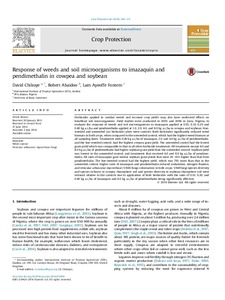| dc.contributor.author | Chikoye, D. |
| dc.contributor.author | Abaidoo, R.C. |
| dc.contributor.author | Fontem, Lum. A. |
| dc.date.accessioned | 2019-12-04T11:03:24Z |
| dc.date.available | 2019-12-04T11:03:24Z |
| dc.date.issued | 2014-11 |
| dc.identifier.citation | Chikoye, D., Abaidoo, R. & Fontem, Lum. A. (2014). Response of weeds and soil microorganisms to imazaquin and pendimethalin in cowpea and soybean. Crop Protection, 65, 168-172. |
| dc.identifier.issn | 0261-2194 |
| dc.identifier.uri | https://hdl.handle.net/20.500.12478/1050 |
| dc.description | Published online 23 August 2014 |
| dc.description.abstract | Herbicides applied to combat weeds and increase crop yields may also have undesired effects on beneficial soil microorganisms. Field studies were conducted in 2005 and 2006 in Zaria, Nigeria, to evaluate the response of weeds and soil microorganisms to imazaquin applied at 0.05, 0.10, 0.20 and 0.40 kg a.i./ha and pendimethalin applied at 1.0, 2.0, 4.0, and 8.0 kg a.i./ha in cowpea and soybean. Hoeweeded and unweeded (no herbicide) plots were controls. Both herbicides significantly reduced weed biomass in both crops, when compared to the unweeded control, which had the highest weed biomass at all sampling dates. Treatments with 0.40 kg a.i./ha of imazaquin, 2.0 and 4.0 kg a.i./ha of pendimethalin, and the hoe-weeded control, had the highest cowpea grain yield. The unweeded control had the lowest grain yield which was comparable to that in all other herbicide treatments. All treatments except 4.0 and 8.0 kg a.i./ha of pendimethalin had higher soybean grain yield than the unweeded control. Soybean yield was lowest in the unweeded control, and treatments that received 4.0 and 8.0 kg a.i./ha of pendimethalin. All rates of imazaquin gave similar soybean grain yields that were 29e41% higher than that from pendimethalin. The hoe-weeded control had the highest yield, which was 79% more than that in the unweeded control. Higher rates of imazaquin and pendimethalin reduced nodulation, nitrogen fixation, and vesicular arbuscular mycorrhizal (VAM) fungi colonisation in both crops. VAM fungi species diversity and species richness in cowpea rhizosphere soil and species diversity in soybean rhizosphere soil were reduced relative to the controls due to application of both herbicides with the rates of 0.10, 0.20, and 0.40 kg a.i./ha of imazaquin and 8.0 kg a.i./ha of pendimethalin being significantly effective. |
| dc.language.iso | en |
| dc.subject | Weed Control |
| dc.subject | Vesicular Arbuscular Mycorrhizae |
| dc.subject | Cowpeas |
| dc.subject | Soybeans |
| dc.title | Response of weeds and soil microorganisms to imazaquin and pendimethalin in cowpea and soybean |
| dc.type | Journal Article |
| dc.description.version | Peer Review |
| cg.contributor.crp | Grain Legumes |
| cg.contributor.affiliation | International Institute of Tropical Agriculture |
| cg.contributor.affiliation | University of Buea |
| cg.coverage.region | Africa |
| cg.coverage.region | West Africa |
| cg.coverage.country | Nigeria |
| cg.isijournal | ISI Journal |
| cg.authorship.types | CGIAR and developing country institute |
| cg.iitasubject | Cowpea |
| cg.iitasubject | Soybean |
| cg.iitasubject | Grain Legumes |
| cg.journal | Crop Protection |
| cg.howpublished | Formally Published |
| cg.accessibilitystatus | Limited Access |
| local.dspaceid | 78048 |
| cg.identifier.doi | https://dx.doi.org/10.1016/j.cropro.2014.07.004 |

